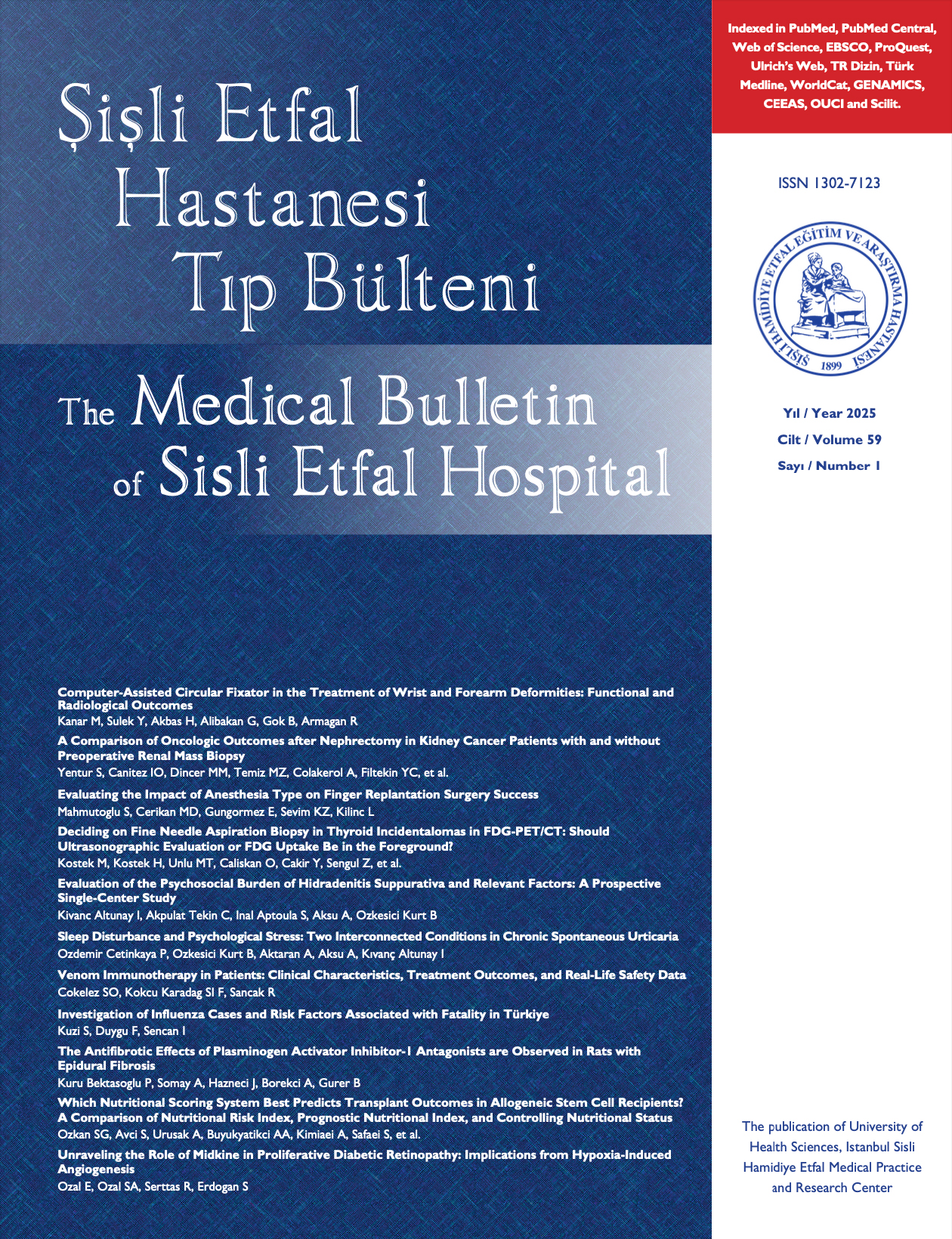
Factors Affecting Breastfeeding and Complementary Feeding Choices for Children Aged 24 to 48 Months
Neslihan Özkul Sağlam, Lida Bülbül, Selcen Yaroğlu Kazancı, Sadık Sami HatipoğluDepartment of Child Health and Disease, Bakirkoy Dr. Sadi Konuk Training and Research Hospital, Istanbul, TurkeyObjectives: The aim of this study was to evaluate factors that affected decisions regarding breastfeeding and complementary feeding practices in children aged 24 to 48 months.
Methods: Children aged 24 to 48 months who were presented at the outpatient clinic of a single hospital over a 6-month period were included in the study. Children who were born prematurely, hospitalized in the neonatal intensive care unit, and those with a chronic disease were excluded. A questionnaire was administered to parents who provided consent. Data related to demographic characteristics, socioeconomic status, and infant nutrition practices were collected and analyzed.
Results: A total of 100 cases were included. The distribution of the gender of the children was 49% female and 51% male, and the mean age was 36.2±7.8 months. The mean duration of exclusive breastfeeding was 4.83±1.23 months, the mean length of total breastfeeding was 17.65±8.44 months, and the mean initiation of complementary feeding was 5.71±1.23 months of age. The most frequent reason provided for the cessation of breastfeeding was the mothers decision to wean. The duration of exclusive breastfeeding and the total length of breastfeeding feeding was significantly shorter among children who were born by cesarean section, and those who used a pacifier and or feeding bottle. Non-working mothers used formula for a longer period (p=0.043) and introduced solid foods and the use of utensils later than other mothers (p=0.001, p=0.03, respectively). Complementary food was provided to the infants of families whose monthly income level was less than TL 1000 earlier than in higher income level groups (p=0.04). The results of this study also showed that complementary food choices were most influenced by older members of the family and members of the mothers immediate circle (42%) and healthcare professionals (36%). Mothers who received information about the addition of complementary food did not demonstrate a significantly different length of time devoted to exclusive breastfeeding; however, the duration of breastfeeding overall, alone and in combination with solid foods, increased (p=0.03).
Conclusion: Before the birth, families should be informed and prepared regarding the necessity of exclusive breastfeeding for the first 6 months and the continuation of breastfeeding until 2 years of age, the potential impact of relevant factors related to the type of birth, and the potentially negative effects of the use of a pacifier or bottle. All members of the family, particularly mothers and close relatives, should be advised about proper complementary feeding techniques, including the need to increase the consistency of food gradually, introducing solid foods before the 10th month, and using natural, home-cooked items instead of prepared foods. The appropriate information and guidance should be provided to all families with consideration for their education level, social environment, and life conditions.
24-48 Ay Arası Çocukların Anne Sütü Alımı ve Tamamlayıcı Beslenme Tercihlerine Etki Eden Faktörler
Neslihan Özkul Sağlam, Lida Bülbül, Selcen Yaroğlu Kazancı, Sadık Sami HatipoğluBakırköy Dr. Sadi Konuk Eğitim ve Araştırma Hastanesi, Çocuk Sağlığı ve Hastalıkları Bölümü, İstanbul, TürkiyeAmaç: Çalışmamızda 24-48 ay arası çocukların anne sütü alımı ve tamamlayıcı beslenme tercihlerine etki eden faktörler değerlendirildi.
Gereç ve yöntem: Çalışmamıza bir yıllık sürede hastanemiz çocuk polikliniğine başvuran yaşları 24-48 ay arası olan çocuklar dahil edildi. Miadından önce doğan, yenidoğan yoğun bakım ünitesinde izlenmiş olan ve kronik hastalığı olan çocuklar çalışmaya alınmadı.
Anket şeklinde düzenlenen çalışmamız dört ana başlıkta toplanan sorulardan oluşmaktaydı; bebek, anne ve ailenin sosyoekonomik durumu ile ilgili demografik özellikler ve çocuk beslenmesi uygulamaları. Veriler ankete katılmayı kabul eden ebeveynler ile bire bir görüşerek elde edildi.
Bulgular: Çalışma 100 olgu ile bir yıllık sürede tamamlandı. Olgular %49u kız ve %51i erkek, ortalama yaşları 36.2±7.8 ay idi. Sadece anne sütü verme süresi 4.8±2.1 ay, toplam emzirme süresi 17.7±8.4 ay, ek gıda başlama zamanı 5.7±1.2 ay bulundu. Emzirmeden kesmenin en sık nedeni annenin süreyi yeterli bulması idi. Sezaryenle doğan, emzik-biberon kullanan bebeklerde sadece ve toplam anne sütü alma süresi anlamlı düzeyde kısa saptandı. Annesi çalışmayan grupta formül mama kullanım oranı yüksek (p: 0.043) iken aynı grupta pürtüklü gıdaya başlama zamanı ile çatal-kaşık kullanmaya başlama zamanı daha geç bulundu (p: 0.001,p: 0.03). Aylık gelir düzeyi 1000 TLnin altında olan ailelerde ek gıda başlama yaşı daha yüksek gelirli gruba göre anlamlı derecede daha erken bulundu (p: 0.04). Ek gıda seçimini etkileyen faktörler; aile büyükleri ve yakın çevre (%42), sağlık personeli (%36) şeklindeydi. Ek gıda hakkında bilgilendirmenin tek başına anne sütü verme süresini etkilemediği ancak toplam anne sütü alma süresini artırdığı (p: 0.03) tespit edildi.
Sonuç: İlk altı ay sadece anne sütü verilmesi ve emzirmenin iki yaşa kadar sürdürülmesi gerektiği, doğum şekli, emzik ve biberon kullanımının zararları konusunda aileler doğumdan önce bilgilendirilmeli ve gerekli önlemler alınmalıdır. Tamamlayıcı beslenme konusunda; besinlerin kıvamının yaşla birlikte dereceli olarak artırılması, katı gıdaların 10. aydan önce başlanması, hazır gıdalar yerine evde hazırlanmış doğal besinlerin tercih edilmesi gerektiği bilgisi anneler başta olmak üzere tüm aile bireyleri ve yakın çevresine verilmelidir. Kişiler mevcut eğitim durumları, sosyal çevreleri ve yaşam koşulları ile beraber değerlendirilmeli ve bilgilendirme
tüm bireyleri kapsamalıdır.
Manuscript Language: English



















